'The simplicity of line of the motor, the purity of design of the chassis, the general harmony of the whole ensemble, can be considered an assurance of perfection'. That was how the great French motoring journalist Charles Faroux summed up the 1929 Hotchkiss: but it's a description that could easily be applied to any of this company's products from the start of production in 1903 to the end in the mid 1950s.
The name of Hotchkiss was renowned long before the company began car production - the story beginning in 1867, when Benjamin Hotchkiss, a Connecticut businessman, arrived in France to set up an armaments factory. This was established in the 1870s at Saint-Denis, a manufacturing suburb, 6 kilometres to the north of Paris.
When the motor age dawned, Hotchkiss found, like so many other armaments manufacturers, that boring out the business end of a cannon was an excellent training for the production of cylinder blocks. Moreover, the world had become a little too peaceful to become profitable, so the company turned first to the manufacture of components for car makers like Panhard and
De Dietrich to earn some extra income.
From there, it was only a short step to the manufacture of complete cars: it was in 1903 that the first Hotchkiss car left the factory. At the wheel was the great racing driver Henri Fournier, who had taken the Paris agency for the marque, a fact perhaps not unconnected with the fact that his brother Achille was the assistant designer of the chassis.
The Hotchkiss Back Axle
This was largely the work of M. Terrasse, who had formerly worked for the
Mors company. With its live-axle drive and neat round radiator, the car, of 17 cv (approximately equal to hp), had an advanced appearance for the period; the layout of its rear drive would become part of motoring's language - 'the Hotchkiss back axle'. The 17 cv Hotchkiss was no mean performer. In August 1905, La Vie au Grand Air noted: 'Mr and Mrs Marshall Dodge have toured throughout France and Switzerland in their 17 cv Hotchkiss, crossing the most difficult passes of the Alps. Our photograph was taken on their return, when Mr Dodge went to the factory at Saint-Denis to congratulate the manufacturers on the perfect running of their vehicle'.
Yet the infant marque was almost stifled at birth, when a fire at the factory coincided with the company's first appearance at the Paris Salon in November 1903, restricting 1904 production to a mere 32 cars. By 1904 the marque was available on the English market, and the agent J. J. Mann had, perhaps unwittingly, made a major contribution to the company's future by wheedling a job for his nephew, H.M. Ainsworth, in the drawing office at Hotchkiss.
Ainsworth was a young man of rare ability, who would rise to become chef de production by the outbreak of war, and guide the company's fortunes throughout the 1920s and 1930s. Ainsworth's associatin ensured that there always was a strong English flavour about the Hotchkiss management, the company had many British shareholders, who had elected an Englishman, Charles Parsons, to the chairmanship in 1898, a post he was to occupy for 22 years.
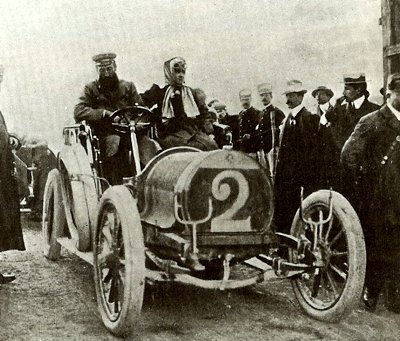 1904 Hotchkiss 20 hp four-cylinder in the 1906 Targa Florio. Despite attempting to break into racing, Hotchkiss were not very successful.
1904 Hotchkiss 20 hp four-cylinder in the 1906 Targa Florio. Despite attempting to break into racing, Hotchkiss were not very successful.
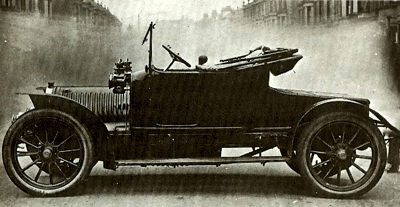 1911 Hotchkiss 16 hp.
1911 Hotchkiss 16 hp.
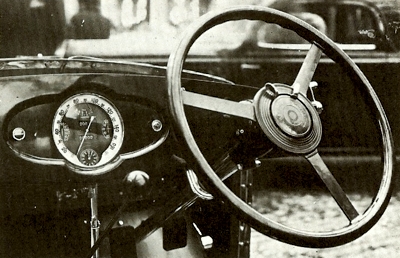 1936 Hotchkiss Spider Dashboard. The speedo went to 160 kph, and housed a clock.
1936 Hotchkiss Spider Dashboard. The speedo went to 160 kph, and housed a clock.
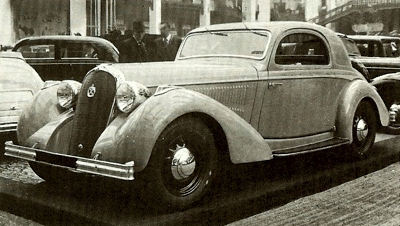 1938 Hotchkiss 686 Coupe.
1938 Hotchkiss 686 Coupe.
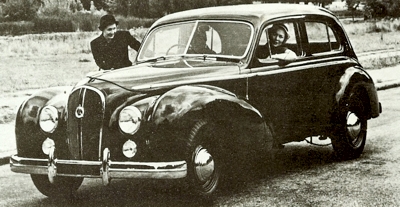 1951 Hotchkiss Sedan.
1951 Hotchkiss Sedan.
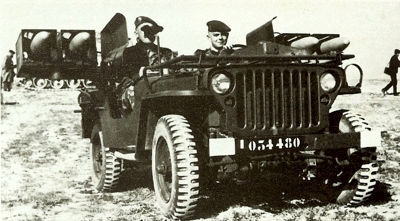 1954 Hotchkiss American Jeep. The company abandoned passenger vehicle production to concentrate on commercial vehicles.
1954 Hotchkiss American Jeep. The company abandoned passenger vehicle production to concentrate on commercial vehicles. |
The 1904 Gordon Bennett Eliminating Trials
The marque was hardly on the market before the obligatory attempts at racing were made. These were never very successful, and were far from characteristic of the company's later achievements. Their first racers appeared at the 1904 Gordon Bennett Eliminating Trials on the Circuit de l'Argonne in May. With their 'upturned-boat' bonnets, gilled-tube radiators and chain drive, they looked more like enlarged versions of the 1903 Mors racers, with 17.8-liter engines.
The 1905 Gordon Bennett Hotchkisses had a mechanical layout more in line with the production models, but 18.8-liter engines crammed into a chassis weighing no more than 1005 kg were apparently too much of a good thing, the best the team could manage was seventh place in the French Gordon Bennett Eliminating Trials.
The company's last attempt to break into big-time racing came in the 1906 Grand Prix, but their sole noteworthy achievement was the rebuilding of a damaged wire wheel by Le Blon, using spokes begged from his team-mates and borrowed from the other three wheels of his own car. Thereafter, Hotchkiss concentrated on long-distance trials to prove the reliability of their machinery.
Hotchkiss introduced their first six-cylinder, at 7.4 liters, in 1906; the cylinders were cast in pairs. Compared with many of its contemporaries, the Hotchkiss six was an excellent, refined and durable car: in 1931 the company featured a 1906 enclosed drive limousine in its advertising.
One of these sixes set out on a 15,000 mile run, officially observed by the Royal Automobile Club, on 29 April 1907, following a route which led it throughout the British Isles; it didn't finish until 20 August, and thereby had its thunder stolen by the new Rolls-Royce Silver Ghost, which had covered a similar observed distance in the interim.
46 Tires Over 15,000 Miles
The reliability record of the Hotchkiss was nearly as good as that of the Rolls - and it spent only a quarter as much time being repaired overnight - but its tire consumption was appalling, even for those days. In 15,000 miles it consumed no fewer than 46 tyres, at a cost of around UK£550, even in those days Hotchkiss, hitherto manufacturers of large cars for the luxury market, moved into the quality light car field in 1909 with the 2.2-liter 12/16hp; the following year the company were offering a five-car range - the 12/16, priced at £340 in chassis form, the 16/20 (£440), the 20/30 (£565) and two sixes, the 20/30 (£600) and the massive 40/50 (£890).
During World War 1 Hotchkiss concentrated on the production of armaments, among their designs being a light machine gun that could be carried on bicycles. So that the German advance on Paris should not hinder production they set up satellite factories at Lyon and Coventry: after the war, the Lyon factory was acquired by Saurer, while Coventry began building engines for Morris, Gilchrist and BSA. In 1923, William Morris, by now one of Britain's biggest motor manufacturers, decided to ensure continuity of supply of his power units, and bought the Coventry Hotchkiss works, and Ainsworth, who had been in charge of the operation, returned to Saint-Denis.
The Hotchkiss Type AM and AM80
Hotchkiss then turned to super-luxury car production with the 1921 Type AK, which had a 6.6-liter engine whose overhead valves were operated by a midget crankshaft acting on hinged flaps rather than a conventional camshaft. The cruciform-braced chassis was exceptionally rigid, and there were servo-assisted brakes on all four wheels. But only one AK was built. By now, the circular radiator of the pre-war models had been replaced by a horse-shoe-shaped cooler of more distinction than most of its contemporaries, and a new, purpose-built factory was taking shape. This would eventually take over production of the new Type AM which would constitute the company's sole product from 1923-28.
This was a refined 2.2-Iitre four with cable-operated braking on all four wheels; initially it had a. side-valve power unit, though this had acquired pushrod ohv by 1926. Ironically, this 12 cv engine was also sold to other manufacturers, including Leon Bolle - who had just been taken over by William Morris. A new Hotchkiss six, the 3-liter AM80, appeared at the Paris Salon at the end of 1928; this would prove to be the basis for all Hotchkiss six-cylinder power until the end of production in 1954. In its first incarnation, the AM80 was clad with bodywork of studied elegance, whose names- Longchamp, Monaco, Vichy, Chantilly, Riviera, Antibes, Deauville and La Baule-are as evocative of their period as their styling.
Taking 46 International Records Despite A Big End Failure
There was a surprise in the chassis department, this was the first production Hotchkiss to abandon the Hotchkiss drive; but its torque tube transmission was only to last until 1933. Proof of the new model's performance was soon evident to all.
In September 1929 a standard six-cylinder saloon driven by De Corvala, Delgutte, Tehernowsky and Vasselle covered a distance of 25,000 miles in 16 days at an average of 65.85 mph, taking 46 international records from 4000 miles to 40,000 kilometres on the Montlhery track. Much of the distance was covered on five cylinders only, due to big-end failure.
In 1932, Vaselle, driving a prototype 3½-liter sporting model which would be catalogued as the AM 80S the following year, gained an easy victory in the Monte Carlo Rally; this was to become a virtual Hotchkiss benefit in the ensuing years, with victories in 1933, 1934, 1939 (this was jointly with Delahaye), 1949 and 1950.
The standard 1932 cars were lower-built, with dropped chassis and rear springs splayed outwards to reduce roll. A new sporting model appeared in 1934, named the Paris-Nice after one of the marque's sporting victories that season; this designation was to be retained for the marque's high-performance line throughout the decade.
But as the performance went up, the styling went downhill, and the standard bodywork began to look staid alongside the products of the other French luxury car makers. Conservatism had always been part of the appeal of the Hotchkiss, but in the restless Thirties it began to be a handicap.
Hotchkiss retained right-hand steering, once the hallmark of the quality French car, right to the end in 1954, when this feature was merely perversely anachronistic, A merger with Amilcar in 1937 produced the Gregoire-designed Amilcar Compound, built in the Hotchkiss factory, which, despite an ambitious test drive from Paris to London via Asia Minor by the motoring journalist W. F. Bradley, never really got into serious production.
When the war came, there was no chance for Hotchkiss to seek safety by decentralisation, as they had in 1914. As the Germans marched on Paris, H. M. Ainsworth fled with a caravan of lorries carrying works records, account books and machine tools. One by one, the lorries fell by the wayside until Ainsworth was on his own: he escaped and eventually made his way to Canada, where he was involved in tank production for the Ministry of Supply.
After the Armistice, Hotchkiss reintroduced the prewar 686 model, accompanied from 1949 by a new 13 cv four. However, post-war Frenchfiscal policy was against the Juxury marques, and Hotchkiss were now virtually priced out of the market. A new Gregoire model, the 2-liter flat-four, front-wheel-drive Hotchkiss-Gregoire, was produced in limited numbers from 1952, but the post-war Hotchkiss story was one of a gentle decline. There was a temporary merger with Peugeot and a permanent one with Delahaye, but restyling could no longer conceal the 3-!-liter's age, despite the adoption of independent front suspension in 1949. So the company ceased car production in 1954 in favour of commercial vehicles.
